Enzymology - Study guides, Revision notes & Summaries
Looking for the best study guides, study notes and summaries about Enzymology? On this page you'll find 101 study documents about Enzymology.
All 101 results
Sort by
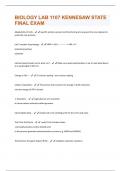 Popular
Popular
-
BIOLOGY LAB 1107 KENNESAW STATE FINAL EXAM 2024 LATEST QUESTIONS & ANSWERS SOLVED 100% CORRECT!
- Exam (elaborations) • 5 pages • 2024
- Available in package deal
-
- £6.50
- 1x sold
- + learn more
Adaptability of Cells - specific proteins present and functioning at one given time are replaced or joined by new proteins. Lab 5 reaction Enzymology - PNPP + H2O -------------> PNP + Pi (colorless) (yellow) substrate Lab five Spectrometer set at what nm? - Make sure spectrophotometer is set to read absorbance at a wavelength of 410 nm. Change in OD = - 15 minute reading - zero minute reading Cellular respiration - The process that converts the energy in food molecules into the energ...
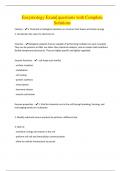
-
Enzymology Exam| questions with Complete Solutions
- Exam (elaborations) • 37 pages • 2024
-
- £10.89
- + learn more
Catalyst - 1. Chemical or biological substance or structure that lowers activation energy 2. Accelerates the rate of a chemical rxn Enzymes - Biological catalysts that are capable of performing multiple rxns (are recycled). They can be proteins or RNA, are faster than chemical catalysts, and act under mild conditions (bodily temperature/pressure). They are highly specific and tightly regulated. Enzyme functions - - cell shape and motility - surface receptors - metabolism - cell cycling ...
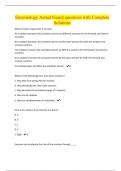
-
Enzymology Actual Exam| questions with Complete Solutions
- Exam (elaborations) • 34 pages • 2024
-
- £10.56
- + learn more
Which of these statements is correct? A) A catalyst decreases the activation barrier by different amounts for the forward and reverse reactions. B) A catalyst decreases the activation barrier by the same amount for both the forward and reverse reactions. C) A catalyst increases the activation barrier by different amounts for the forward and reverse reactions. D) A catalyst increases the activation barrier by the same amount for both the forward and reverse reactions. E) A catalyst does ...
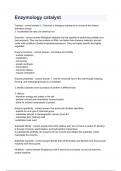
-
Enzymology catalyst Questions & answers
- Exam (elaborations) • 23 pages • 2024
- Available in package deal
-
- £6.50
- + learn more
Enzymology catalyst Questions & answers
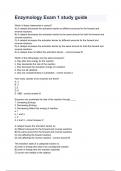
-
Enzymology Exam 1 study guide Questions & answers
- Exam (elaborations) • 20 pages • 2024
- Available in package deal
-
- £6.50
- + learn more
Enzymology Exam 1 study guide Questions & answers
Enzymology kinetics Questions & answers
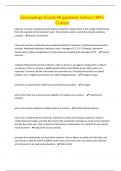
-
Enzymology Exam| 60 questions Solved 100% Correct
- Exam (elaborations) • 8 pages • 2024
-
- £9.75
- + learn more
enzymes increase reactions by lowering the activation energy-which is the energy needed to go from the reactant to the transition state. The transition state is called the enzyme substrate complex - function of enzymes Classes of enzymes: oxidoreductase-oxidation/reduction reactions, transferase-group transfer reaction, hydrolase-hydrolytic reactions, lyase- cleavage of C-C C-S C-N bonds, isomerase- isomerization, ligase-condensation of two molecules coupled with cleavage of ATP. - class of...
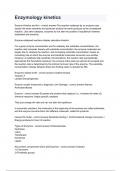
-
Enzymology kinetics Questions & answers
- Exam (elaborations) • 5 pages • 2024
- Available in package deal
-
- £6.50
- + learn more
Enzyme Kinetics and Km - correct answer-The reaction catalysed by an enzyme uses exactly the same reactants and produces exactly the same products as the uncatalysed reaction. Like other catalysts, enzymes do not alter the position of equilibrium between substrates and products. Enzyme-catalysed reactions display saturation kinetics: For a given enzyme concentration and for relatively low substrate concentrations, the reaction rate increases linearly with substrate concentration; the enzym...
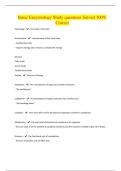
-
Basic Enzymology Study questions Solved 100% Correct
- Exam (elaborations) • 9 pages • 2024
-
- £9.75
- + learn more
Physiology - - The study of function Homeostasis - - maintenance of the same state - maintaining order - requires energy and a means to utilized the energy Glucose Fatty Acids Amino Acids Volatile Fatty Acids Ketone - - Sources of energy

-
Enzymology Questions & answers
- Exam (elaborations) • 5 pages • 2024
- Available in package deal
-
- £6.50
- + learn more
Enzymology Questions & answers

-
Enzymology for Clinical Chemistry.
- Exam (elaborations) • 4 pages • 2024
- Available in package deal
-
- £6.50
- + learn more
Enzyme - correct answer-A PROTEIN that acts as a biochemical CATALYST by affecting the rate at which a reaction proceeds. Substrate - correct answer-The material acted on by the enzyme Product - correct answer-The material produced as the result of an enzyme acting upon a substrate. 1. Enzyme binds to substrate at their active site 2. [ES] complex brings substrate molecule into proper alignment with enzyme 3. Products are formed and the free enzyme can combine with excess free substrate ...

That summary you just bought made someone very happy. Also get paid weekly? Sell your revision notes on Stuvia! Discover all about earning on Stuvia




